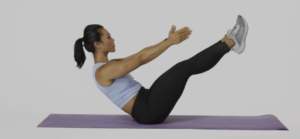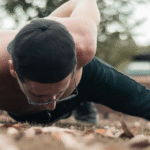V-Sit: Sculpt Your Abs with This Challenging Exercise
The V-sit is a challenging bodyweight exercise that targets the abdominal muscles and hip flexors. It involves balancing on your sit bones while simultaneously lifting your legs and torso off the ground, forming a “V” shape with your body. This exercise requires significant core strength, stability, and balance, making it a great addition to any core strengthening routine.
Key Muscle Groups Involved:
Rectus Abdominis: This muscle, often referred to as the “six-pack,” is responsible for flexing the spine and bringing the ribcage closer to the pelvis. It plays a crucial role in maintaining the V-sit position.
Obliques: The internal and external obliques, located on the sides of the abdomen, are responsible for rotating and laterally flexing the torso. They help stabilize the body during the V-sit and prevent excessive rotation.
Hip Flexors: The hip flexors, a group of muscles located on the front of the hip, are responsible for flexing the hip joint and bringing the legs closer to the torso. They play a vital role in lifting and holding the legs in the V-sit position.
Transverse Abdominis: This deep core muscle acts as a natural corset, providing stability and support to the spine and pelvis. It is essential for maintaining proper form and preventing lower back pain during the V-sit.
Technique:
Starting Position: Begin by sitting on the floor with your legs extended in front of you and your arms by your sides.
Lift: Engage your core muscles and lean back slightly, lifting your legs off the ground while simultaneously raising your torso.
Balance: Find your balance point by adjusting the angle between your torso and legs. Aim for a 45-degree angle or as close to it as possible.
Hold: Maintain a straight back and keep your core engaged throughout the hold. Extend your arms forward or reach towards your shins for an added challenge.
Lower: Slowly lower your legs and torso back to the starting position, maintaining control throughout the movement.
Benefits:
Increased Core Strength: The V-sit is a highly effective exercise for strengthening the entire core, including the rectus abdominis, obliques, and transverse abdominis.
Improved Balance: It challenges your balance and coordination, helping you develop better body awareness and control.
Enhanced Stability: The V-sit strengthens the muscles responsible for stabilizing the spine and pelvis, which can help prevent lower back pain and improve posture.
Increased Hip Flexor Strength: It strengthens the hip flexors, which are important for various activities, including running, jumping, and climbing.
Progressions:
Tucked V-Sit: Start with your knees bent and tucked towards your chest. This reduces the lever arm and makes the exercise easier.
Single-Leg V-Sit: Extend one leg out while keeping the other leg tucked. Alternate legs to build strength and balance.
Modified V-Sit: Place your hands behind your hips for support. This reduces the load on your core and makes the exercise more accessible.
Full V-Sit: Perform the V-sit with both legs extended and your arms reaching forward.
Tips:
Start with proper progressions: Don’t attempt the full V-sit until you have mastered the easier variations.
Focus on form: Maintain a straight back and avoid rounding your spine.
Engage your core: Keep your core muscles engaged throughout the exercise.
Breathe deeply: Don’t hold your breath. Breathe deeply and rhythmically to ensure proper oxygen flow.
Practice regularly: Consistent practice is key to mastering the V-sit and reaping its benefits.
The V-sit is a challenging but rewarding exercise that can help you sculpt your abs and develop exceptional core strength. With dedication and consistent effort, you can master this impressive feat of bodyweight training.

V-Sit: Sculpt Your Abs with This Challenging Exercise
Route
Calisthenics Gym Houston Functional Bodyweight Training
Secondary phone: (346) 483-3195
Email: info@calisthenicsclubhouston.com
URL: https://calisthenicsclubhouston.com/
Monday 6:00 AM - 7:00 PM Tuesday 6:00 AM - 7:00 PM Wednesday 6:00 AM - 7:00 PM Open now Thursday 6:00 AM - 7:00 PM Friday 12:00 PM - 6:30 PM Saturday 9:45 AM - 12:00 PM Sunday 3:00 PM - 5:00 PM





